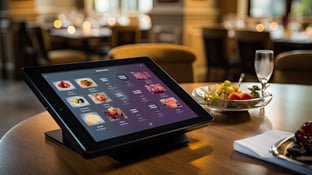For a server, running back and forth across the dining room is just part of the job. And with a traditional kiosk-based point-of-sale (POS) system, it’s a nonstop undertaking.
Let’s take a look at a typical scenario:
- Server takes table’s drink order → server runs to the POS
-
Server takes appetizer and entree order → server runs to the POS
-
Ketchup, please → server heads straight to the POS
-
Here comes the second round of drinks → server strolls on back to the POS
-
Who’s having dessert? → and we’re back
-
Check, please → sixth time the server’s at the POS
-
Payment and receipt → hello, old friend, we meet again, and then again
Depending on the restaurant, a server might swing by the POS three to seven times for every single table. It’s a time-consuming process, and lately more restaurants are trying to eliminate it.
How? With a handheld POS.
What’s a Handheld POS?
These portable systems allow servers to take and enter orders from a tablet or, in some cases, their own smartphone. This means a server can store an entire POS in their apron, and orders can be fired before they walk away from the table.
Most handheld POS options also have integrated payment solutions, eliminating the back-and-forth of dropping the check, going to run the payment, and returning with the receipt.
All of this saves time and, of course, energy on behalf of waitstaff. But is it worth making the switch if you already have a traditional POS kiosk in place?
If you’re running a full-service restaurant, it’s something to at least consider. We break down what you’d need to know to get the most out of a potential transition.
Benefits of Investing in a Handheld POS
According to the National Restaurant Association’s 2024 Tech Landscape Report, just under half of full- and limited-service restaurants (48%) will invest in point-of-sale solutions over the next year. Payoffs include:
- More tables with less stress: According to estimates from Toast, a POS solution provider, handheld systems help restaurants turn tables up to 20% faster without asking servers to work harder than they already are. Eliminating wait times and back and forth will allow servers to enjoy the occasional breather while still bringing drinks and food to tables more quickly.
- Fewer wrong orders: In the past, order accuracy may have slipped because of imperfect memory or illegible handwriting. When servers can input orders directly into a mobile device, they all but eliminate the chances of a mix-up and dramatically simplify their jobs. No more scrambling to keep orders from multiple tables straight or digging through apron pockets for tickets!
- Faster, simpler checkouts: Handheld and tableside POS systems streamline the full dining experience, from ordering to checkout. Many systems accept newer forms of payment such as Google Pay and Apple Pay and feature tap-to-pay compatibility. That’s far simpler and less time-consuming than the traditional method of running cards to and from a kiosk-based POS.
- An avenue for advertising: Bringing the point of sale device tableside makes it easier than ever to sell both new and returning customers on the value of signing up for your loyalty program. Highlighting the right membership perk or touting potential savings opportunities could get customers to sign up on the spot. You may find that this method of driving sign-ups is more effective (not to mention more cost effective) than other promotional marketing channels. Toast reports that customers have seen sign-ups increase tenfold thanks to its mobile POS technology.
- A lifesaver during busy hours: If you’ve got more customers than you can handle, a handheld POS device could serve a valuable “line-busting" role. Whether you deploy the solution to capture reservation details or punch in takeout orders, it can useful for minimizing the time your customers spend just standing and waiting.
All of this adds up to happier customers and a happier staff. Speedy service, short wait-times, and the chance to save with loyalty points will all turn customers into regulars and spread positive word of mouth. Engaging with happy diners and collecting better tips without extra effort can help you boost employee retention at a time when restaurants can’t afford to lose employees.
Choosing the Right Handheld Point-of-Sale for Restaurants
The restaurant tech landscape is just as crowded as the restaurant industry itself. Surveying all the available options, sorting out the best-fit contenders, and making the most of investments can overwhelm even veteran operators.
We spoke to a restaurant tech expert for his thoughts on reviewing, implementing, and getting the highest possible ROI from handheld points-of-sale for restaurants. Andy Freivogel, the co-founder and CEO of Science on Call, shared quick tips, identified common pitfalls, and described what to expect from the mobile POS marketplace.
What’s on the Menu?
If you’re already using a cloud-based POS solution, chances are you can transition to handheld sales without switching providers. Taking your front of house into a new era may not even require sitting through a sales presentation. Freivogel estimates that nearly 80 to 90 percent of POS solutions offer some type of handheld option. This includes popular providers such as Lightspeed, Square, and Toast.
If you haven’t transitioned to a cloud-based system, though, you may need to switch providers. Handheld technology “is an area where the legacy POS solutions, like NCR Aloha and [Oracle] MICROS, have really fallen behind,” Freivogel warns.
Don’t forget to ask your provider about how the POS system will integrate with the rest of your tech stack or if there are additional opportunities to innovate. Pay-at-the-table integrations are especially important for realizing all the benefits noted above.
Would You Like a Mobile Device With That?
If you need to find a new provider, Freivogel recommends looking for providers who offer their own proprietary handheld devices. Fortunately, all the handheld-friendly companies named above fit the bill.
To minimize the risk of dropped devices or complicated on-boarding, ask the sales rep if you can take their solution for a test run. Trials can help you pick out solutions that are easy to manage and unlikely to disrupt your usual workflows. Your team will appreciate the opportunity to familiarize themselves with new tools in a low-pressure setting instead of trying out a potentially complicated POS solution for the first time during a busy shift.
It may seem as though allowing servers to upload POS systems to their own phones and tablets would offer added convenience. Freivogel warns, however, that this approach has its own sets of challenges and liabilities. Think of the added complications if a server breaks their phone or is distracted by incoming texts and calls.
Check, Please!
In addition to upfront costs of $300 to $600 for hardware, switching to handheld point-of-sale for restaurants typically means paying subscription fees on a per-device basis. Depending on the number of devices they purchase, Freivogel recommends budgeting an additional $25 to $30 each month for subscriptions.
Remember, though, that you shouldn’t make an investment like this based on price alone. As Freivogel puts it, “Cost is an issue, but without reliability and performance, it’s not worth doing, even if it’s free.”
Beyond standard costs, you may want to invest an extra $100 or so for a shockproof case. That may sound steep, but Freivogel stresses the importance of keeping new devices safe. Deep-pocketed aprons offer another level of protection for costly and fragile POS technology.
Save Room for Training, Onboarding, and Troubleshooting
Introducing new mobile POS technology is a big move. As such, you should make sure to keep your team looped in on the selection process and set aside the appropriate time for on-boarding and training. Freivogel says operators should give their staff at least a few hours to try out devices before sending them out to brave a crowded dining room.
“Training [from the POS providers] is actually hard to come by,” says Freivogel. “Sometimes there’s bundled ‘training’ that includes a 45-minute video call, but it's very hard to teach a team how to use a new system this way, so the more time you can spend up front testing, the better outcome you can expect.”
Learning the ins and outs of the system ahead of time will ensure front-of-house employees feel confident in their abilities during peak hours. After the initial training, don’t forget about assessments to check for understanding and refreshers to make sure your staff is getting the most out of the tech's available functions.
It’s also important to consider where you’ll use the devices, so that you can test the Wi-Fi strength in those areas. In some cases, you may need to invest in an upgraded internet plan. “Make sure it's a wireless network that connects to the same data network as the rest of the POS solution – you can't use a handheld on ‘Jimmy's BBQ Guest’ and expect it to print to the kitchen,” says Freivogel.
Introducing a new POS solution may also mean adding new processes to your opening or closing shifts. For example, how will your team handle charging mobile devices overnight? Without a plan in place and a well-trained closing staff, “the morning crew could be in for a rocky start,” Freivogel points out.
Pricing for Portable POS Systems
Cost is, of course, another major factor to consider when adopting any restaurant tech. Typically with a handheld POS, there’s an upfront device cost, though some, like Square, have an app that staff can download to their personal phones. Additionally, there’s usually a monthly, per-device software fee.
Prices will vary, but Freivogel recommends budgeting $300 to $600 for the upfront cost and $25 to $30 per device each month. Be sure to shop around, but it’s important to test out a POS before immediately jumping on the cheapest option.
“Cost is an issue, but without reliability and performance, it's not worth doing, even if it's free,” says Freivogel.
Should Your Restaurant Adopt a Handheld Point of Sale?
You’re the best person to answer that question, but Back of House can help you explore your options. Our guide will help you learn more about how to pick the ideal solution for your restaurant’s needs, the size of your staff, and your technology budget.
You Can’t Afford to Choose the Wrong POS
Thankfully, our experts put together a comprehensive guide with everything you need to know in order to choose the right POS system.





